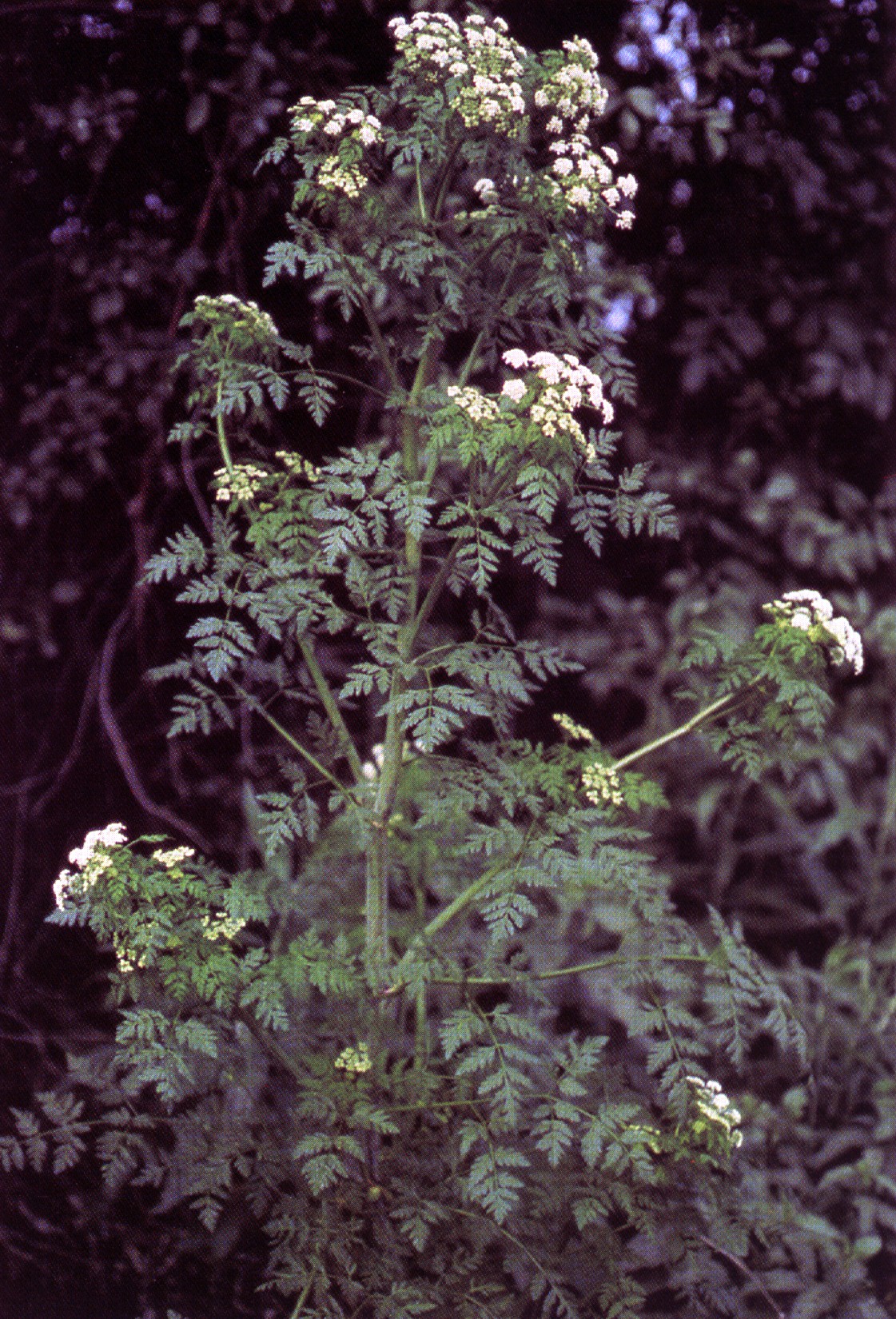|
Conium
''Conium'' ( or ) is a genus of flowering plants in the family Apiaceae. , Plants of the World Online accepts six species. All species of the genus are poisonous to humans. ''C. maculatum'', also known as hemlock, is infamous for being highly poisonous. Hemlock is native to temperate regions of Europe, North Africa and Western Asia. The species ''C. chaerophylloides'', ''C. fontanum'', and ''C. sphaerocarpum'' are all native to southern Africa. Description Plants of the genus ''Conium'' are eudicots, flowering plants distinguished by their two cotyledons (embryonic leaves) and tricolpate (three-pored) pollen. They are typically biennial, forming basal rosettes in the first year of growth, and sprouting a rigid, hollow flower stalk in the second. Germination occurs between spring and autumn. Occasionally, plants which germinate in early spring are annual instead of biennial. These plants grow best in wet, poorly drained areas with nutrient rich soil. They grow well in nitrogen ... [...More Info...] [...Related Items...] OR: [Wikipedia] [Google] [Baidu] |
Conium Maculatum
''Conium maculatum'', commonly known as hemlock (British English) or poison hemlock (American English), is a highly poisonous flowering plant in the carrot family Apiaceae, native to Europe and North Africa. It is Herbaceous plant, herbaceous, with no woody parts, and has a Biennial plant, biennial lifecycle. Hemlock is a hardy plant capable of living in a variety of environments and is now widely naturalised in locations outside its native range, including parts of Australia, West Asia, and North and South America, to which it has been introduced. It is capable of spreading and thereby becoming an Invasive plant, invasive weed. All parts of the hemlock plant are Toxic plant, toxic, particularly the seeds and roots, and especially when ingested. Under the right conditions, the plant grows quite rapidly during the growing season, and can reach heights of , with a long Taproot, penetrating root. The plant has a distinctive odour that is usually considered unpleasant and carries with ... [...More Info...] [...Related Items...] OR: [Wikipedia] [Google] [Baidu] |
Coniine
Coniine is a poisonous chemical compound, an alkaloid present in and isolable from poison hemlock ('' Conium maculatum''), where its presence has been a source of significant economic, medical, and historico-cultural interest; coniine is also produced by the yellow pitcher plant (''Sarracenia flava''), and fool's parsley ('' Aethusa cynapium''). Its ingestion and extended exposure are toxic to humans and all classes of livestock; its mechanism of poisoning involves disruption of the central nervous system, with death caused by respiratory paralysis. The biosynthesis of coniine contains as its penultimate step the non- enzymatic cyclisation of 5-oxooctylamine to γ-coniceine, a Schiff base differing from coniine only by its carbon-nitrogen double bond in the ring. This pathway results in natural coniine that is a mixture—a racemate—composed of two enantiomers, the stereoisomers (''S'')-(+)-coniine and (''R'')-(−)-coniine, depending on the direction taken by the chain th ... [...More Info...] [...Related Items...] OR: [Wikipedia] [Google] [Baidu] |
Cicuta
''Cicuta'', commonly known as water hemlock, is a genus of four species of highly poisonous plants in the family Apiaceae. They are perennial herbaceous plants which grow up to tall, having distinctive small green or white flowers arranged in an umbrella shape (umbel). Plants in this genus may also be referred to as cowbane or poison parsnip. ''Cicuta'' is native to temperate regions of the Northern Hemisphere, mainly North America and Europe, typically growing in wet meadows, along streambanks and other wet and marshy areas. These plants bear a close resemblance to other members in the family Apiaceae and may be confused with a number of edible or poisonous plants. The common name hemlock may also be confused with poison hemlock (''Conium maculatum''), or with the Hemlock tree. Water hemlock is considered one of North America's most toxic plants, being highly poisonous to humans. Three members of the genus contain a toxin named cicutoxin which causes central nervous system sti ... [...More Info...] [...Related Items...] OR: [Wikipedia] [Google] [Baidu] |
Conium Divaricatum
''Conium divaricatum'' is a species of flowering plant in the family Apiaceae, native to Greece, including Crete. It was first described in 1856. The plant is phytochemically distinct from conium maculatum, and is considered a separate species. The Classical Greek philosopher Socrates Socrates (; ; – 399 BC) was a Ancient Greek philosophy, Greek philosopher from Classical Athens, Athens who is credited as the founder of Western philosophy and as among the first moral philosophers of the Ethics, ethical tradition ... is believed to have been executed with hemlock, though scholars are unsure whether it was c. maculatum or c. divaricatum. References Apioideae Flora of Crete Flora of Greece Plants described in 1856 {{Apiaceae-stub ... [...More Info...] [...Related Items...] OR: [Wikipedia] [Google] [Baidu] |
Apiaceae
Apiaceae () or Umbelliferae is a family of mostly aromatic flowering plants named after the type genus ''Apium,'' and commonly known as the celery, carrot, or parsley family, or simply as umbellifers. It is the 16th-largest family of flowering plants, with more than 3,800 species in about 446 genus, genera,Stevens, P.F. (2001 onwards).APIACEAE Lindley, nom. cons. ''Angiosperm Phylogeny Website''. Retrieved 16 December 2022. including such well-known, and economically important plants as ajwain, angelica, anise, Ferula assa-foetida, asafoetida, caraway, carrot, celery, chervil, coriander, cumin, dill, fennel, lovage, cow parsley, parsley, parsnip and Eryngium maritimum, sea holly, as well as Silphium (antiquity), silphium, a plant whose exact identity is unclear and which may be extinct. The family Apiaceae includes a significant number of phototoxic species, such as giant hogweed, and a smaller number of highly poisonous species, such as Conium maculatum, poison hemlock, Cicuta, ... [...More Info...] [...Related Items...] OR: [Wikipedia] [Google] [Baidu] |
Socrates
Socrates (; ; – 399 BC) was a Ancient Greek philosophy, Greek philosopher from Classical Athens, Athens who is credited as the founder of Western philosophy and as among the first moral philosophers of the Ethics, ethical tradition of thought. An enigmatic figure, Socrates authored no texts and is known mainly through the posthumous accounts of classical writers, particularly his students Plato and Xenophon. These accounts are written as dialogues, in which Socrates and his interlocutors examine a subject in the style of question and answer; they gave rise to the Socratic dialogue literary genre. Contradictory accounts of Socrates make a reconstruction of his philosophy nearly impossible, a situation known as the Socratic problem. Socrates was a polarizing figure in Athenian society. In 399 BC, he was accused of Asebeia, impiety and corrupting the youth. After Trial of Socrates, a trial that lasted a day, he was sentenced to death. He spent his last day in prison ... [...More Info...] [...Related Items...] OR: [Wikipedia] [Google] [Baidu] |
N-Methylconiine
''N''-Methylconiine is a poisonous alkaloid found in poison hemlock in small quantities. Isolation and properties The -(+)-stereoisomer of ''N''-methylconiine is reported to occur in hemlock in small quantities, and methods for its isolation are described by Wolffenstein and by von Braun. It is a colourless, oily, coniine-like liquid, specific rotation �sub>D +81.33° at 24.3 °C. The salts are crystalline ("B" marks one molecule of the base): the hydrochloride, B•HCl, forms masses of needles, mp. 188 °C; the platinichloride, B2•H2PtCl6, has mp. 158 °C. The -(−)-stereoisomer was obtained by Ahrens from residues left in the isolation of coniine as hydrobromide or by removing coniine as the nitroso-compound. It is a colourless, coniine-like liquid, bp. 175.6 °C/767 mmHg, specific rotation �sub>D −81.92° at 20 °C. The monohydrochloride crystallises in leaflets, mp. 191–192 °C; the monohydrobromide in leaflets, mp. 189–190 ° ... [...More Info...] [...Related Items...] OR: [Wikipedia] [Google] [Baidu] |



